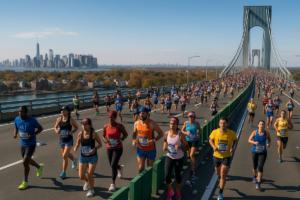

Leaf Peeping in London: 10 Places to See the Autumn Leaves Change Colour
Leaf Peeping is fast becoming a go-to activity on crisp autumn days – also in London. As the foliage turns from lush green to fiery shades of red, orange, and yellow, the trick with leaf peeping is to catch the view before they fall to the ground.
With more than 250 parks, the capital is one of the best places in the world to observe the autumn leaves as they change colours. With this in mind, the travel experts at LuggageHero have put together their top 10 places to enjoy this incredible spectacle.
#1 Hyde Park
It is the best known of all parks in the heart of the British capital. On sunny days, it is a popular spot for skaters, runners, and cyclists. Those that want to take it slowly can rent a pedal boat on the Serpentine or stroll along the many paths. 3174 trees make Hyde Park the perfect location for sports, relaxation or even a romantic date under the falling leaves. The most common trees in the park are London Plane, Lime, Sweet Chestnut and English Oak.
Hyde Park was originally established as a hunting ground by Henry VIII in 1536 and measures in total 350 acres. It can easily be accessed from different sides via Tube stations such as Marble Arch, Hyde Park Corner or Knightsbridge. Oxford street is just around the corner for your autumnal shopping trip.

#2 Regent’s Park
Another of the Royal Parks of London is The Regent’s Park a bit further north in the city. It is close to the popular Camden Town with its stalls and alternative culture. The ZSL London Zoo is located within the park and invites for an autumnal walk with exotic and domestic animals while you watch the kaleidoscopic spectrum of colours that the trees offer at this time of the year.
The Regent’s Park measures 410 acres and was originally known as Marylebone Park – another hunting and forestry ground for Henry VIII. Nearby Tube stations are Regent’s Park, Great Portland Street and Baker Street.

#3 Little Venice, Grand Union Canal & Regent’s Canal
Not far from Regent’s Park is Little Venice with its canals and waterways that start at Paddington Basin. Along the canals, you can rent a boat, a paddle board or get on a barge to explore the Grand Union and Regent’s Canal. The latter brings you through the Maida Hill Tunnel to Regent’s Park and the Zoo all the way to Camden Town. If you prefer a walk, you will enjoy the promenade along the canal that provides stunning views of terraced town houses and the green trees below that transform into fiery red come autumn.
The best Tube stations to reach Little Venice are Paddington, Warwick Avenue and Royal Oak.

#4 Green Park
Within a short distance from Hyde Park and in between Buckingham Palace and the famous Ritz Hotel is Green Park, another one of the Royal Parks in London. As the name suggests, there is a lot of greenery to enjoy during the summer, which begins to turn red and orange when the days get shorter. At lunchtime, you usually see many professionals in their best suits enjoying their well-deserved break in the sun or under the falling leaves.
Green Park primarily consists of Plane and Lime trees, but you can also find the Black Poplar, Silver Maples and Silver Limes. There are no lakes or buildings in Green Park, and it is with only 19 hectares one of the smallest parks in the British capital. It is recommended to do your autumnal walk in the late morning hours to see the changing of the Guards at Buckingham Palace at 11 a.m.
The closest Tube station is Green Park station directly at the entrance of the park.

#5 St. James’s Park
Close to Hyde Park and Green Park is the most easterly of the Royal Parks in Central London, St. James’s Park. With only 23 hectares it is slightly bigger than Green Park and invites for short walks. In the park is a small lake with two islands and a blue bridge that perfectly frames a view towards Buckingham Palace in between the trees that are changing colours every autumn. The park is home to around 1250 individual trees from around 35 species, the majority of which are London Plane trees, but you can also find Fig trees and Tibetan cherry trees.
Originally a hunting ground too, under James I in the early 17th century the park was home to exotic animals such as camels, crocodiles and an elephant. The closest Tube stations are St. James’s Park, Green Park, Victoria and Westminster.

#6 Chelsea Embankment
The British capital always invites visitors for a stroll along the river Thames, be it from Westminster to the London Eye and the Southbank Centre or along the iconic Tower Bridge. Some parts of the river walk, and Thames Embankment are framed by trees which change their colours and provide the perfect frame for a foliage picture of London.
Chelsea Embankment was originally built as part of a modern sewage system in the 19th century and is now a spot for romantic walks or a morning run. It is part of the Royal Borough of Kensington and Chelsea; the closest Tube station is Sloane Square.

#7 Holland Park & Kyoto Gardens
Also part of Kensington and not far from the famous Notting Hill is Holland Park which is the name for an area of Victorian houses that is known to be one of the richest in London, and also the name of a Park in the same area that covers 22 hectares and is home to more than 400 tree species. Although half of the park is semi-wild woodland, it is mostly known for its formal garden areas and the Kyoto Gardens.
The Kyoto Gardens were opened in 1991 as a gift from Kyoto to commemorate the friendship between Great Britain and Japan. As any Japanese garden, there is a serene pond full of koi carp and tiered waterfalls framed by maple trees – add some autumnal colour to it and you have the most beautiful spot for a walk in the foliage. The Kyoto Gardens are easy to reach from Holland Park, Notting Hill Gate or Kensington High Street Tube stations.

#8 Greenwich Park
On the opposite of the city, in south east London is Greenwich Park. It was the first of the Royal Parks to be enclosed in the early 15th century, measuring 74 hectares and counting almost 4000 trees. The ancient and veteran tree stock consists of sweet chestnuts, oaks, a sycamore and a cedar.
The park is part of the Greenwich World Heritage Site with the National Maritime Museum on the northern edge. The southern part is on a hill which offers one of the best views towards central London with Canary Wharf framing the silhouette. On top of the hill is the Royal Observatory from where the colourful trees at this time of the year make for an iconic London picture.
The closest Tube station is North Greenwich from where it is recommended to take a bus. Alternatively, you can take a train from Central London to Greenwich, Maze Hill or Blackheath and walk from there.

#9 Richmond Park
Famous as a deer park and the biggest of the Royal Parks in London is Richmond Park in South West London. The 955-acre park belongs to the boroughs of Richmond and Kingston and was created by Charles I. Its original purpose was a deer park which it is to this day. You can easily spot them on your walk through the falling leaves, they only add on to the photogenic landscape that could be taken out of a documentary about the Indian summer – the warm synonym for fall foliage in North America.
There are more than 1200 ancient trees, some of which predate the park’s enclosure, and the oldest oak trees in London. Richmond Park is also part of the London Cycle Network and a famous spot to get a good workout. The closest Tube station is Richmond from where you can take a bus to the entrance of the park.

#10 Alexandra Palace
The last, but not least, of the beautiful London spots to see the leaves change colour is Alexandra Palace, or Ally Pally how the Londoners say. The palace itself is a recreational centre and was opened in 1873. Inside the palace are for example an ice rink, a theatre, and an event venue. Its location on top of the hill within Alexandra Park provides panoramic views over the city of London from the North side that is framed by the kaleidoscopic colour palette of the leaves. There are a total of 7,500 trees to admire in the heart of Ally Pally.
Ally Pally can be reached by underground to the station Wood Green or by train to the station Alexandra Palace. From the station, you can take a lovely walk through the park and up to the palace. After the climb, you will have deserved the views you can enjoy from the top on a sunny autumn day in London.



